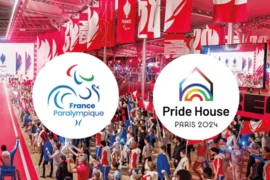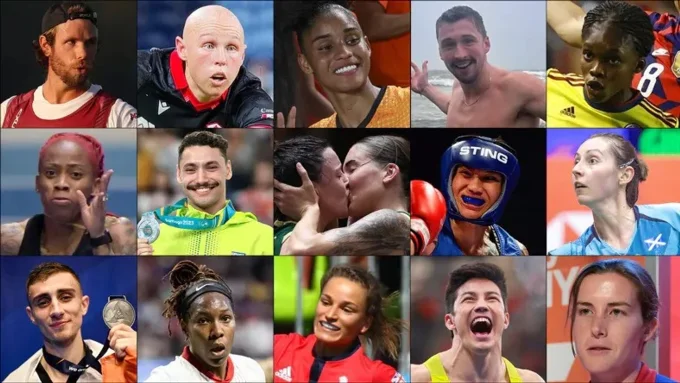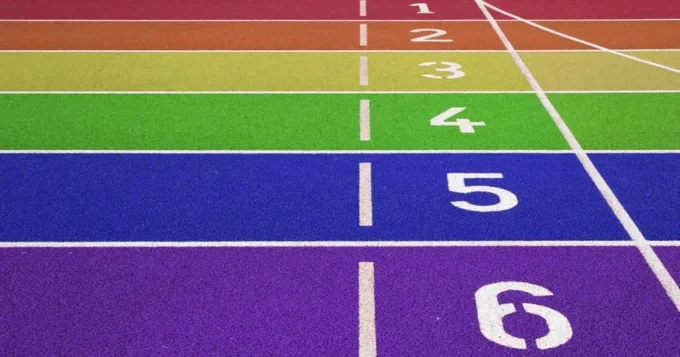What's up: Sports and safe places for LGBTQ+ athletes: Paris 2024 Olympics and Paralympics

In this month’s What’s up student column, our EUSA ESC volunteer, Ms Milia Molinie elaborates on the topic of "Sports and safe places for LGBTQ+ athletes", presenting her own point of view and analysis of Paris 2024 Olympics and Paralympics.
At least 199 out LGBTQ+ athletes took part in the Paris 2024 Summer Olympic and Paralympic Games, according to the LGBTQ sports website OutSports. This number has increased from the past Tokyo Olympics held in 2021, where there were at least 186 out competitors. This is a record-breaking number for public LGBTQ representation through sports, as it is happening through an international event.
This data came along with a record-breaking television audience, said the IOC, during the summer, especially during both Paris 2024 Opening ceremonies. Indeed, the opening ceremonies held on July 26th and August 28th gathered over 35 millions of viewers on public television.
Thomas Jolly, the Artistic director who orchestrated both ceremonies, adopted a clear alignment with the Paris 2024 Games slogan “Games Wide Open”, not only because of the public setting of the events, but also through the messages shared by the artists. In fact, even though the opening ceremonies, particularly the first one, provoked mixed reactions and triggered controversy, both of them were a clear statement for the Olympics and Paralympics to be a safe place for LGBTQ+ athletes, along with the settlement of a Pride House during the summer, which the international press approved.
First of all, the Opening ceremonies played a key role in building a safe place for LGBTQ+ athletes through the “Wide Open” format across the city center, and the place de la Concorde.
In fact, the previously mentioned controversy was a clear reaction to the militant cultural performances featured by openly LGBTQ+ artists who proudly call themselves Queer. This very reaction happened because of the visibility given to the gender and sexual minorities who took over the main stage all across the city, instead of adopting avoidance strategies in an urban context. Then, the whole city was depicted as a safe place to celebrate and party, regardless of sexual orientation or gender identity. Indeed, with drag queens, openly queer artists and numerous references to LGBTQ+ culture, Thomas Jolly helped “queering the city”, as Kath Brown conceived, by redrawing, remapping historical places and monuments. The river Seine, for instance, where statues were erected in tribute to the fight for social rights, became a “female force of resistance” according to several media. Alongside, visibility was given to underground cultures such as the ballroom scene during the runway. Ballroom culture was born as a symbol of resistance created by African-American and Latino LGBTQ+ subculture. By giving space to this alternative art, Thomas Jolly and Tony Estanguet, Paris 2024 chairman, wanted to prove that there was “room for everyone in Paris”, by stepping outside the box to make everyone feel represented in it, through an intersectional approach.

This need for representation, through sports especially, represents a major challenge and a crucial need to make sports an inclusive environment. Indeed, the middle-distance runner Niki Hiltz from team USA who came out as nonbinary affirmed through an interview given to ABC News: “It is hard to be someone that you can not see.” This message was well received from the organisers of both opening ceremonies, as many LGBTQ+ artists were the main characters of the stages during these two evenings. We saw for instance drag queens such as Piche and Nicky Doll proudly walking the runway by questioning gender-conforming through their art. Then, Raya Martigny, a French model and transgender woman, was wearing the French flag on her jumpsuit, as a symbol of freedom and equality. Finally, we could dance to the DJ's beats of Barbara Butch, who is a lesbian activist through music and inclusive parties. A main focus was put on visibility also to different body types, to fight against discrimination based on physical appearance and gender identity, in particular in the light of questionings on representations of body norms in sports.
The Paralympic opening ceremony was definitely aligned with this commitment, through the live performance of Lucky Love, a disabled and queer French singer who often questions masculinity in his songs. Finally, we could see Rahim Redcar, former singer of the project Christine and the Queen, who recently came out as transgender, performing a song from the French singer Edith Piaf on the Place de la Concorde, surrounded by dancers with and without disabilities, as a symbol of unity.
Finally, representation was settled as a main objective, to make not only athletes, but also each viewer across the globe, feel they belong to such an important event, by normalising alternative representations, out in the open.
Furthermore, during the Paris2024 Olympics and Paralympics, we were able to attend clear manifestations of open mindedness towards LGBTQ+ during the sports events. This can be read as a consequence of structural progress within sports federation and IOC guidelines. In fact, the number 4 Fundamental Principle of the Olympic Charter considers the practice of sport as a “Human right… without discrimination of any kind”, and the Paris 2024 Organizing Committee set a priority to organise an inclusive and responsible event.
These commitments together with the impact of the Opening Ceremonies led to many joyful celebrations from LGBTQ+ athletes together with their family. As Billie Jean King, legendary tennis star and LGBTQ+ activist said, “sports are a microcosm of our society”, and we were able to see some LGBT celebrating moments on live TV. For instance, team USA rugby player Alev Kelter proposed to her girlfriend after she led her team to the bronze medal. Then, Australian sports climber Campbell Harrison kissed his partner after competing, and Alice Bellandi judoka went hug her family and kissed her girlfriend after winning a gold medal. Then, during the Paralympics, we could see the French paralympic cyclist Marie Patouillet celebrating her gold medal by kissing her wife before standing for the French national anthem.
Along with these loving demonstrations and celebrations, we noticed some LGBTQ+ symbols, such as Tom Daley’s (UK swimmer) rainbow towel. All these elements contribute to building a safer place for athletes seeking representation. In fact, R.K. Russel, former NFL player who came out as bisexual in 2019 said that his coming out “freed (him) from the doubt that (he) did not belong in the world of sports as a bisexual man or that (he) did not belong in the hypermasculine sport of football”. This testimony highlights the fact that for generations, LGBTQ+ people have felt marginalised in sports, because they did not belong to the heteronormative representations of athletes broadcasted through the media and the collective imagination.
Finally, alongside these celebration moments both during the opening ceremonies and the games, just like Billie Jean King affirmed that as sports reflect society, we sadly witnessed discrimination and harassment behaviours linked to the topic of LGBTQ+ representation. In fact, in the same way as some scenes from the ceremonies did lead to controversies, there are still major achievements to make on the field. The harassment that the Algerian boxer Imane Khelif suffered from relates to a “lack of female representation in coaching and leadership, and a lack of research into the prevalence of harassment and sexual abuse of women in boxing”, according to former boxer Anne Tjonndal. These gaps led to widespread misinformation and unfounded allegations that targeted both women and gender minorities. This analysis is even more relevant given that the vast majority of athletes on the list of queer Olympians (approximately 170), are women.

To conclude, Paris 2024 Opening Ceremonies stood as cultural performances on diversity and inclusion by presenting a multifaceted, multiethnic France reaching out to the rest of the world. Just like the artists did, by stepping onto the world stage as their true selves, many athletes are challenging stereotypes and inspiring young people who feel underseen or gaslighted. There is a major need for representation of LGBTQ+ identities, especially during sports events, as it is an occasion to gather and build bridges between cultures and nations.
The results through the OUTSPORTS project, the first European survey, led by the German Sport University Cologne, conducted in 2019 on sexual orientation, gender identity and sports, show that 20% of the participants do not practise their sport for fear of being discriminated against, excluded, or harassed. Alongside public representation, there is also a need for structural changes through sport organisations. There is a need to devote resources for educating sports stakeholders and incentivizing young athletes to continue practising sports in what we could proudly and finally call “safe places”. Nowadays, more and more NGOs are advocating for the use of inclusive practices into sport federations, by signing charters and sharing good practices and training. These efforts are needed to make an effective transition to turn representation into concrete action.
Today, weeks after the Paris Olympics, we know that a third of all out LGBTQ+ out athletes at the Paris Olympics went home with at least one medal. This represents a further step towards ensuring sports as an environment of authenticity and freedom for all orientations and identities out in the world.
The author of the text is Milia Molinie from France, graduate with a Master degree in international cooperation and development from both universities of Bordeaux, France and Turin, Italy, who is currently serving as a European Solidarity Corps volunteer at the EUSA Office in Ljubljana.
